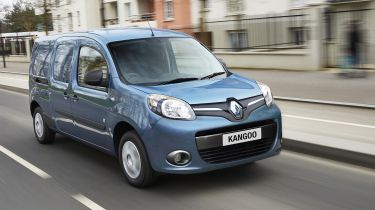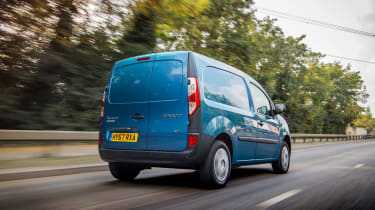Renault Kangoo E-TECH electric (2011-2021) review
With a wide choice of body styles, the Renault Kangoo electric is more versatile than its main rivals – although this version has now been discontinued and a replacement is coming soon
Pros
- Choice of bodies
- Competitively priced
- Latest battery technology
Cons
- Not very quick
- Cheap materials
- No fast charging
| Van type | Range | Wallbox charge time | Rapid charge time |
|---|---|---|---|
| Electric | 143 miles | 11hrs (0-100%) | N/a |
The Renault Kangoo was an early frontrunner in the electric light commercial vehicle (LCV) class, courtesy of Renault’s commitment to constantly developing its battery and electric-motor technology. Add the fact that it was offered in a range of bodystyles and it had plenty going for it. It's showing its age these days, however. During 2022 it'll be replaced by an all-new generation, featuring the latest battery and charging technology.
Now known as the Kangoo E-TECH, the van was originally badged Kangoo Z.E. when it launched in 2011. It uses similar technology to the Renault ZOE supermini, with a 33kWh battery pack that doesn’t compromise load volume and an electric motor that makes 60bhp.
Renault quotes an official driving range of 143 miles for the electric Kangoo, but admits you’re more likely to get 124 miles out of a charge. It also highlights the limitations of cold weather, stating that you’re likely to experience a range of 75 miles when the temperature drops and you use the heating. There's an ‘ECO’ switch on the dash that reduces throttle response at lower speeds to help boost range, although the extra effort needed to get the van moving when this is activated counters any real benefit the system offers.
There’s a single charging socket on the Kangoo E-TECH, located behind the blue-tinted Renault badge on the nose. It has a standard Type 2 port behind it and a six-metre charging cable comes as standard. The manufacturer quotes a 17-hour charge time from empty using a standard three-pin socket, or six hours from a home wallbox. The Kangoo E-TECH doesn't have rapid-charging capability – a major omission that will be rectified with the debut of the new version mentioned above.
As the Kangoo E-TECH shares its bodyshell and non-electric drive components with the diesel version, it can be offered in the same sizes. As a result, there’s a standard van, the Maxi extended-wheelbase variant, the Maxi Crew version with a three-person rear bench and the Maxi Crew Cab, which offers a multi-positional bulkhead, so you can carry passengers or more cargo.
The range starts with Business trim, which is modestly equipped, but you can upgrade to interior pre-heating and cooling to help maintain your driving range. There's also the Business+ model, introduced in June 2020, which Renault says features over £1,000 worth of equipment for just £600 more than the Business version's list price. Metallic paint, body-coloured front and rear bumpers, powered folding door mirrors, a central armrest, an overhead parcel and a practical rubber floor covering for the load area all thrown in, while the Business+ also gets one-touch electric front windows and rear parking sensors.
On the road, the Kangoo E-TECH delivers a typical electric-vehicle driving experience. The modest power output means that while the van jumps off the line eagerly, it quickly runs out of steam. The running gear is pretty dated, with the platform able to trace its roots back more than a decade. That means the driving experience isn’t much fun, while the extra weight of the batteries makes the E-TECH feel ponderous and slow to change direction, especially in Maxi guise. There’s plenty of load space, though, and the total payload volume isn’t far behind the diesel Kangoo’s.
The interior is also showing signs of age. There’s masses of grey plastic and some flimsy switches dotted around, but at least Renault offers a touchscreen sat nav. You also have the option to set the heater to bring the cab up to temperature at a set time when the van is plugged in and charging.
Overall, the Renault Kangoo E-TECH is well suited to urban use, and there’s every likelihood that if you use it in this environment you’ll be able to drive it all day without needing to recharge. It’s a shame the rest of the package around the electric running gear is so basic, even in commercial-vehicle terms, but the new version coming in 2022 is expected to remedy a lot of those shortcomings. For a more detailed look at the Renault Kangoo E-TECH, read on for the rest of our in-depth review...


